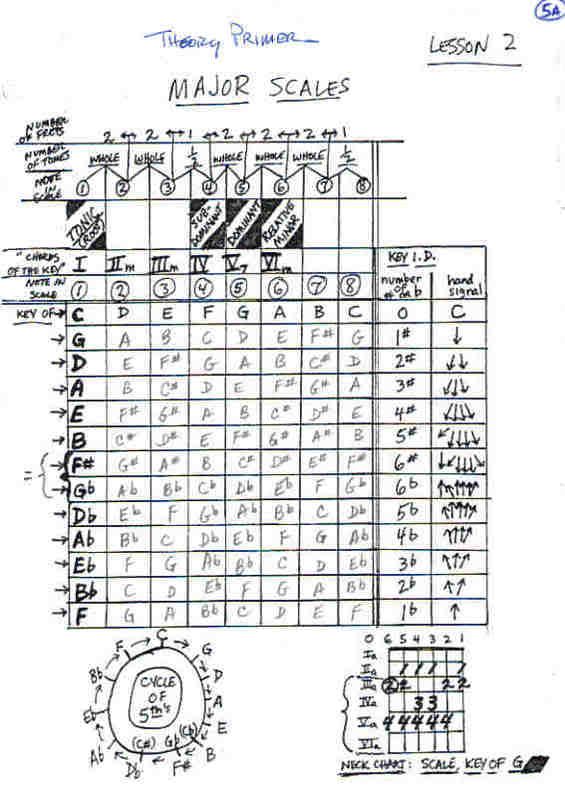
It ain't pretty, but I put this one-sheet reference chart together ages ago based on stuff I picked up from workshops with other New York City area players at The Guitar Study Center, run by Happy Traum, a name some might recognize from lesson books published in the 60's & 70's.

I've used it as a core piece in teaching, so that's why it's labeled 'Theory Primer' & 'Lesson 2'.
The 'Hand Signals' at the far right were used in studio settings to silently call out the key of the tune. Key of C is 'home', the signal being thumb & forefinger shaping a 'C', holding fingers down or up for the number of sharps or flats from C to call out another key. (why the illogical up for flats and down for sharps? dunno. never asked. I was dumb enuff and you never questioned older cats) Since most of us couldn't actually sight read 'real' music to save our lives, we'd have a shorthand chart for a tune giving us the I-IV-V's, etc., with slashes indicating beats & measures for each chord, but no key specified.
^^
AXES: Fender '81 The STRAT, '12 Standard Tele, '78 Musicmaster Bass, '13 CN-240SCE Thinline; Rickenbacker '82 360-12BWB; Epiphone '05 Casino, '08 John Lennon EJ-160E; Guild '70 D-40NT; Ovation '99 Celebrity CS-257; Yamaha '96 FG411CE-12; Washburn '05 M6SW Mando, '08 Oscar Schmidt OU250Bell Uke; Johnson '96 JR-200-SB Squareneck Reso; Hofner '07 Icon B-Bass; Ibanez '12 AR-325. AMPS: Tech 21 Trademark 10; Peavey ValveKing Royal 8; Fender Acoustonic 90, Passport Mini, Mini Tonemaster; Marshall MS-2 Micro Stack; Behringer BX-108 Thunderbird; Tom Scholz Rockman. PEDALS/FX: Boss ME-50; Yamaha EMP100; Stage DE-1; Samson C-Com 16 L.R. Baggs ParaAcoustic D.I; MXR EQ-10.






 Reply With Quote
Reply With Quote
 : . Anyone else??????
: . Anyone else?????? Maybe somebody who actually knows music theory can come along and do that. Yeah, in C the I-IV-V chords are C-F-G. As for the IIm, IIIm and VIm, if you play the chords that way in sequence, (C-Dm-Em-F-G-Am-B-C) you'll hear a nice, natural sounding scale. It sounds good. Play the II, III & VI chords as D-E-A and it 'doesn't leave the door open' to climb to the next note. It sounds bad.
Maybe somebody who actually knows music theory can come along and do that. Yeah, in C the I-IV-V chords are C-F-G. As for the IIm, IIIm and VIm, if you play the chords that way in sequence, (C-Dm-Em-F-G-Am-B-C) you'll hear a nice, natural sounding scale. It sounds good. Play the II, III & VI chords as D-E-A and it 'doesn't leave the door open' to climb to the next note. It sounds bad. I taught/teach kids to play stuff they wann play quick. If they wanna know why, I refer them to a 'real' teacher.
I taught/teach kids to play stuff they wann play quick. If they wanna know why, I refer them to a 'real' teacher.








 :
: